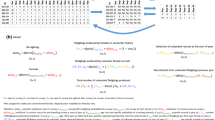Abstract
A logistic density-dependent matrix model is developed in which the matrices contain only parameters and recruitment is a function of adult population density. The model was applied to simulate introductions of white-tailed deer into an area; the fitted model predicted a carrying capacity of 215 deer, which was close to the observed carrying capacity of 220 deer. The rate of population increase depends on the dominant eigenvalue of the Leslie matrix, and the age structure of the simulated population approaches a stable age distribution at the carrying capacity, which was similar to that generated by the Leslie matrix. The logistic equation has been applied to study many phenomena, and the matrix model can be applied to these same processes. For example, random variation can be added to life history parameters, and population abundances generated with random effects on fecundity show both the affect of annual variation in fecundity and a longer-term pattern resulting from the age structure.
Similar content being viewed by others
References
Beddington, J. R. and R. M. May. 1977. Harvesting natural populations in a randomly fluctuating environment.Science 197, 463–465.
Caswell, H. 1989.Matrix Population Models. Sunderland, MA: Sinauer Associated, Inc.
Charnov, E. L. 1993.Life History Invariants. New York: Oxford University Press.
Clark, C. W. 1973. The economics of overexploitation.Science 181, 630–634.
Crouse, D. T., L. B. Crowder and H. Caswell. 1987. A stage-based population model for loggerhead sea turtles and implications for conservation.Ecology 68, 1412–1423.
Gordon, H. S. 1954. The economic theory of a common property resource: the fishery.J. Pol. Econ. 62, 124–142.
Heppell, S. S., J. R. Walters and L. B. Crowder. 1994. Ealuating management alternatives for red-cockaded woodpeckers: a modeling approach.J. Wildlife Management 58, 479–487.
Hutchinson, G. E. 1948. Circular causal systems in ecology.Ann. N.Y. Acad. Sci. 50, 221–246.
Jensen, A. L. 1995. Simple density dependent matrix model for population projection.Ecol. Model. 77, 43–48.
Jensen, A. L. 1996. Density dependent matrix yield equation for optimum harvest of age structured populations.Ecol. Model. 88, 125–132.
Leigh, E. C. 1981. The average lifetime of a population in a varying environment.J. Theor. Biol. 90, 213–239.
Leslie, P. H. 1945. On the use of matrices in certain population mathematics.Biometrika 33, 183–212.
Liu, L. and J. E. Cohen. 1987. Equilibrium and local stability in a logistic matrix model for age-structured populations.J. Math. Biol. 25, 73–88.
May, R. M. 1974. Biological populations with non-overlapping generations: stable points, stable cycles, and chaos.Science 186, 645–647.
McCullough, D. R. 1979.The George Reserve Deer Herd. Ann Arbor: University of Michigan Press.
Pielou, E. C. 1969.An Introduction to Mathematical Ecology. New York: Wiley.
Schaefer, M. B. 1954. Some aspects of the dynamics of populations important to the management of the commercial marine fisheries.Bull. Inter-Am. Trop. Tuna Comm. 1, 27–56.
Starfield, A. M. and A. L. Bleloch. 1986.Building Models for Conservation and Wildlife Management. New York: Macmillan.
Author information
Authors and Affiliations
Rights and permissions
About this article
Cite this article
Jensen, A.L. Matrix population model with density-dependent recruitment for assessment of age-structured wildlife populations. Bltn Mathcal Biology 59, 255–262 (1997). https://doi.org/10.1007/BF02462003
Received:
Accepted:
Issue Date:
DOI: https://doi.org/10.1007/BF02462003




